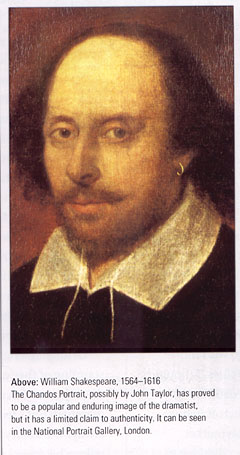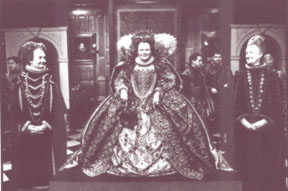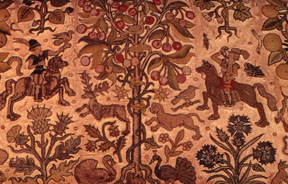|
Hats
were elaborate -- richly ornamented and embroidered. Married women wore
them on the street and at home, unmarried women didn't. Men wore hats
indoors too, and uncovered when the Queen entered or left a room. Early
Elizabethan hats were tall steeple hats, or conical "copintakes"
and the low-crowned wide-brimmed or unbrimmed hat was also very popular.
The brimmed type was, in the next century, adopted by the Cavaliers.
Hats were made of velvet, silk, taffeta, beaver and ermine. Coifs, hoods,
cauls, and caps were also worn...
Men
no less than women went in for elaborate and complicated dress and often
wore a fortune on their backs. The whole point of the Ralegh story is
that a man's cloak was frequently the most valuable part of his wardrobe,
costing hundreds of pounds....
Another
gentlemen, Robert Sidney, in a letter to John Harrington describes the
dress he wore the day Elizabeth visited him....He was clad, he says,
"in a rich band and collar of needlework, a dress of rich stuff
and bravest-cut and fashioned with an underbody
of silver and loops."
Men,
almost as much as women, were given to the use of cosmetics, and were
as vain about the cut and colour of a beard as they were about the cut
and colour of doublet and hose. Harrison, in the middle of a "dry
mock" on fashions in dress, drops in a "bitter taunt"
or two about masculine beard- and hair-styles. "I say nothing of
our heads" he remarks-with paralipsis worthy of Mark Antony--"which
sometimes are polled, sometimes curled or suffered to grow at length
like woman's locks, many times cut off, above or under the ears,
round as by a wooden dish. Neither", says he, "will I meddle
with our variety of beards" and then meddles delightfully.
Some were "shaven from the chin like those of Turks"; others
were cut short like that of Marquess Otto, or rounded like a "rubbing
brush". Some had the "pique de vant", others were  allowed
to grow long. Barbers, on the whole, the parson says, were as cunning
as tailors when it came to making a beard alter the shape of a face
or cover some fancied facial defect. The long, lean, straight face could
be made to look broad and large by a Marquess Otto cut. The owner of
a 'platter-liken face need not be too unhappy, as a long narrow
beard quite altered the flat, plate-like look. For the "weasel-becked",
much hair left on the cheeks would make the owner look "big like
a bowdled-hen and as grim as a goose.. These seem singularly unattractive
alternatives; there can be little to choose between resembling a stoat
or a barnyard fowl. Harrison, too, strikes the note that all this --
and all this included the wearing of earrings of gold set with stones
and pearls -- is an offence to the Lord since men were attempting to
amend the faces God gave them. allowed
to grow long. Barbers, on the whole, the parson says, were as cunning
as tailors when it came to making a beard alter the shape of a face
or cover some fancied facial defect. The long, lean, straight face could
be made to look broad and large by a Marquess Otto cut. The owner of
a 'platter-liken face need not be too unhappy, as a long narrow
beard quite altered the flat, plate-like look. For the "weasel-becked",
much hair left on the cheeks would make the owner look "big like
a bowdled-hen and as grim as a goose.. These seem singularly unattractive
alternatives; there can be little to choose between resembling a stoat
or a barnyard fowl. Harrison, too, strikes the note that all this --
and all this included the wearing of earrings of gold set with stones
and pearls -- is an offence to the Lord since men were attempting to
amend the faces God gave them.
Shakespeare's
Hotspur was impatient of the Elizabethan dandy. "Popinjays"
he calls them and describes, for the benefit of Henry IV, how, after
the battle of Holmedon when he was himself breathless, faint, dry with
rage and toil
"Came
there a certain lord, neat, and trimly dress'd,
Fresh as a bridegroom; and his chin, new reap'd
Showed like a stubble-land at harvest home;
He was perfumed like a milliner,
And 'twixt his finger and his thumb he held
A pouncet-box which ever and anon
He gave his nose..."
Excerpted from "The Pageant of Elizabethan
England" by Elizabeth Burton
|

 allowed
to grow long. Barbers, on the whole, the parson says, were as cunning
as tailors when it came to making a beard alter the shape of a face
or cover some fancied facial defect. The long, lean, straight face could
be made to look broad and large by a Marquess Otto cut. The owner of
a 'platter-liken face need not be too unhappy, as a long narrow
beard quite altered the flat, plate-like look. For the "weasel-becked",
much hair left on the cheeks would make the owner look "big like
a bowdled-hen and as grim as a goose.. These seem singularly unattractive
alternatives; there can be little to choose between resembling a stoat
or a barnyard fowl. Harrison, too, strikes the note that all this --
and all this included the wearing of earrings of gold set with stones
and pearls -- is an offence to the Lord since men were attempting to
amend the faces God gave them.
allowed
to grow long. Barbers, on the whole, the parson says, were as cunning
as tailors when it came to making a beard alter the shape of a face
or cover some fancied facial defect. The long, lean, straight face could
be made to look broad and large by a Marquess Otto cut. The owner of
a 'platter-liken face need not be too unhappy, as a long narrow
beard quite altered the flat, plate-like look. For the "weasel-becked",
much hair left on the cheeks would make the owner look "big like
a bowdled-hen and as grim as a goose.. These seem singularly unattractive
alternatives; there can be little to choose between resembling a stoat
or a barnyard fowl. Harrison, too, strikes the note that all this --
and all this included the wearing of earrings of gold set with stones
and pearls -- is an offence to the Lord since men were attempting to
amend the faces God gave them.
 hung with rich tapestry
of pure gold and fine silks, so exceedingly beautiful and royally ornamented
that it would hardly be possible to find more magnificent things of
the kind in any other place. In particular, there is one apartment belonging
to the Queen, in which she is accustomed to sit in state, costly beyond
everything; the tapestries are garnished with gold, pearls and
precious stones, one table-cover alone is valued at above fifty thousand
crowns--not to mention the royal throne studded with very large
diamonds, rubies, sapphires and the like that glitter among other precious
stones and pearls as the sun among the stars."...
hung with rich tapestry
of pure gold and fine silks, so exceedingly beautiful and royally ornamented
that it would hardly be possible to find more magnificent things of
the kind in any other place. In particular, there is one apartment belonging
to the Queen, in which she is accustomed to sit in state, costly beyond
everything; the tapestries are garnished with gold, pearls and
precious stones, one table-cover alone is valued at above fifty thousand
crowns--not to mention the royal throne studded with very large
diamonds, rubies, sapphires and the like that glitter among other precious
stones and pearls as the sun among the stars."...